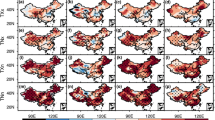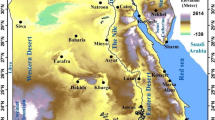Abstract
The persistent temperature and precipitation extremes may bring damage to the economy and human due to their intensity, duration and areal coverage. Understanding the quality of reanalysis datasets in descripting these extreme events is important for detection, attribution and model evaluation. In this study, the performances of two reanalysis datasets [the twentieth century reanalysis (20CR) and Interim ECMWF reanalysis (ERA-Interim)] in reproducing the persistent temperature and precipitation extremes in China are evaluated. For the persistent temperature extremes, the two datasets can better capture the intensity indices than the frequency indices. The increasing/decreasing trend of persistent warm/cold extremes has been reasonably detected by the two datasets, particularly in the northern part of China. The ERA-Interim better reproduces the climatology and tendency of persistent warm extremes, while the 20CR has better skill to depict the persistent cold extremes. For the persistent precipitation extremes, the two datasets have the ability to reproduce the maximum consecutive 5-day precipitation. The two datasets largely underestimate the maximum consecutive dry days over the northern part of China, while overestimate the maximum consecutive wet days over the southern part of China. For the response of the precipitation extremes against the temperature variations, the ERA-Interim has good ability to depict the relationship among persistent precipitation extremes, local persistent temperature extremes, and global temperature variations over specific regions.














Similar content being viewed by others
References
Alexander LV, Zhang X, Peterson TC, et al. (2006) Global observed changes in daily climate extremes of temperature and precipitation. J Geophys Res 111:D05109. doi:10.1029/2005JD006290
Allan RP, Soden BJ (2008) Atmospheric warming and the amplification of precipitation extremes. Science 321:1481–1484. doi:10.1126/science.1160787
Bao X, Zhang F (2013) Evaluation of NCEP–CFSR, NCEP–NCAR, ERA-interim, and ERA-40 reanalysis datasets against independent sounding observations over the Tibetan plateau. J Clim 26:206–214. doi:10.1175/JCLI-D-12-00056.1
Berg P, Moseley C, Haerter JO (2013) Strong increase in convective precipitation in response to higher temperatures. Nat Geosci 6:181–185. doi:10.1038/ngeo1731
Bosilovich MG, Chen J, Robertson FR, Adler RF (2008) Evaluation of global precipitation in reanalyses. J Appl Meteorol Climatol 47:2279–2299. doi:10.1175/2008JAMC1921.1
Chen R, Lu R (2014) Large-scale circulation anomalies associated with “tropical night” weather in Beijing, China. Int J Climatol 34:1980–1989. doi:10.1002/joc.3815
Chen R, Lu R (2015) Comparisons of the circulation anomalies associated with extreme heat in different regions of eastern China. J Clim. doi:10.1175/JCLI-D-14-00818.1
Chen Y, Zhai P (2015) Mechanisms for concurrent low-latitude circulation anomalies responsible for persistent extreme precipitation in the Yangtze River valley. Clim Dyn. doi:10.1007/s00382-015-2885-6
Compo GP, Whitaker JS, Sardeshmukh PD, et al. (2011) The twentieth century reanalysis project. Q J R Meteorol Soc 137:1–28. doi:10.1002/qj.776
Dee DP, Uppala SM, Simmons AJ, et al. (2011) The ERA-interim reanalysis: configuration and performance of the data assimilation system. Q J R Meteorol Soc 137:553–597. doi:10.1002/qj.828
Donat MG, Alexander LV, Yang H, et al. (2013) Global land-based datasets for monitoring climatic extremes. Bull Am Meteorol Soc 94:997–1006. doi:10.1175/BAMS-D-12-00109.1
Donat MG, Sillmann J, Wild S, et al. (2014) Consistency of temperature and precipitation extremes across various global gridded in situ and reanalysis datasets. J Clim. doi:10.1175/JCLI-D-13-00405.1
Frich P, Alexander LV, Della-Marta P, et al. (2002) Observed coherent changes in climatic extremes during the second half of the twentieth century. Clim Res 19:193–212. doi:10.3354/cr019193
Hodges KI, Lee RW, Bengtsson L (2011) A comparison of extratropical cyclones in recent reanalyses ERA-interim, NASA MERRA, NCEP CFSR, and JRA-25. J Clim 24:4888–4906. doi:10.1175/2011JCLI4097.1
Huang D, Qian Y, Zhu J (2010) Trends of temperature extremes in China and their relationship with global temperature anomalies. Adv Atmos Sci 27:937–946. doi:10.1007/s00376-009-9085-4.1
Huang D, Zhu J, Zhang Y, et al. (2016) Assessment of summer monsoon precipitation derived from five reanalysis datasets over East Asia. Q J R Meteorol Soc 142:108–119. doi:10.1002/qj.2634
Ivancic TJ, Shaw SB (2016) A U.S. based analysis of the ability of the clausius-clapeyron relationship to explain changes in extreme rainfall with changing temperature. J Geophys Res Atmos. doi:10.1002/2015JD024288
Kendall M (1975) Rank correlation methods, 4th edn. Charles Griffin, London
Lenderink G, van Meijgaard E (2008) Increase in hourly precipitation extremes beyond expectations from temperature changes. Nat Geosci 1:511–514. doi:10.1038/ngeo262
Lenderink G, van Meijgaard E (2010) Linking increases in hourly precipitation extremes to atmospheric temperature and moisture changes. Environ Res Lett 5:025208. doi:10.1088/1748-9326/5/2/025208
Li G, Harrison SP, Bartlein PJ, et al. (2013) Precipitation scaling with temperature in warm and cold climates: an analysis of CMIP5 simulations. Geophys Res Lett 40:4018–4024. doi:10.1002/grl.50730
Liao Z, Zhang Y (2013) Concurrent variation between the east Asian subtropical jet and polar front jet during persistent snowstorm period in 2008 winter over southern China. J Geophys Res Atmos 118:6360–6373. doi:10.1002/jgrd.50558
Lin R, Zhou T, Qian Y (2014) Evaluation of global monsoon precipitation changes based on five reanalysis datasets. J Clim 27:1271–1289. doi:10.1175/JCLI-D-13-00215.1
Lu R, Chen R (2016) A review of recent studies on extreme heat in China. Atmos Ocean Sci Lett 9:114–121. doi:10.1080/16742834.2016.1133071
Ma L, Zhang T, Li Q, et al. (2008) Evaluation of ERA-40, NCEP-1, and NCEP-2 reanalysis air temperatures with ground-based measurements in China. J Geophys Res Atmos 113:1–15. doi:10.1029/2007JD009549
Ma L, Zhang T, Frauenfeld OW, et al. (2009) Evaluation of precipitation from the ERA-40, NCEP-1, and NCEP-2 reanalyses and CMAP-1, CMAP-2, and GPCP-2 with ground-based measurements in China. J Geophys Res 114:D09105. doi:10.1029/2008JD011178
Mann H (1945) Non-parametric tests against trend. Econometrica 13:245–259
Morice CP, Kennedy JJ, Rayner NA, Jones PD (2012) Quantifying uncertainties in global and regional temperature change using an ensemble of observational estimates: the HadCRUT4 data set. J Geophys Res 117:D08101. doi:10.1029/2011JD017187
Nicholls N (2004) The changing nature of Australian droughts. Clim Chang 63:323–336
O’Gorman PA, Schneider T (2009) The physical basis for increases in precipitation extremes in simulations of 21st-century climate change. Proc Natl Acad Sci U S A 106:14773–14777. doi:10.1073/pnas.0907610106
Smith SR, Legler DM, Verzone KV (2001) Quantifying uncertainties in NCEP reanalyses using high-quality research vessel observations. J Clim 14:4062–4072
Sun Y, Zhang X, Zwiers FW, et al. (2014) Rapid increase in the risk of extreme summer heat in eastern China. Nat Clim Chang 4:1082–1085. doi:10.1038/nclimate2410
Trenberth K, Shea D (2005) Relationships between precipitation and surface temperature. Geophys Res Lett. doi:10.1029/2005GL022760
Trenberth KE, Stepaniak DP, Hurrell JW (2001) Quality of reanalyses in the tropics. J Clim 14:1499–1510
Westra S, Fowler HJ, Evans JP, et al. (2014) Future changes to the intensity and frequency of short-duration extreme rainfall. Rev Geophys 52:522–555. doi:10.1002/2014RG000464
Williams IN, Torn MS, Riley WJ, Wehner MF (2014) Impacts of climate extremes on gross primary production under global warming. Environ Res Lett 9:094011. doi:10.1088/1748-9326/9/9/094011
Wu FT, Fu CB (2013) Change of precipitation intensity spectra at different spatial scales under warming conditions. Chinese Sci Bull 58:1385–1394. doi:10.1007/s11434-013-5699-0
Ye H, Fetzer EJ, Behrangi A, et al. (2016) Increasing daily precipitation intensity associated with warmer air temperatures over northern Eurasia. J Clim 29:623–636. doi:10.1175/JCLI-D-14-00771.1
Yin H, Donat MG, Alexander LV, Sun Y (2015) Multi-dataset comparison of gridded observed temperature and precipitation extremes over China. Int J Climatol 35:2809–2827. doi:10.1002/joc.4174
You Q, Fraedrich K, Min J, et al. (2013) Can temperature extremes in China be calculated from reanalysis? Glob Planet Change 111:268–279
Zhao T, Fu C (2006a) Preliminary comparison and analysis between ERA-40, NCEP-2 reanalysis and observations over China. Clim Environ Res (in Chinese) 11:14–32
Zhao T, Fu C (2006b) Comparison of products from ERA-40, NCEP-2, and CRU with station data for summer precipitation over China. Adv Atmos Sci 23:593–604
Acknowledgments
This study is jointly sponsored by by the National Key Research and Development Program of China (Grant Nos. 2016YFA0600701 and 2016YFA0601504),the National Natural Science Foundation of China (Grant Nos. 41575071 and 51190091), Key Laboratory of Meteorological Disaster of Ministry of Education, Nanjing University of Information Science and Technology (KLME1502), and the Jiangsu Collaborative Innovation Center for Climate Change.
Author information
Authors and Affiliations
Corresponding author
Rights and permissions
About this article
Cite this article
Zhu, J., Huang, DQ., Yan, PW. et al. Can reanalysis datasets describe the persistent temperature and precipitation extremes over China?. Theor Appl Climatol 130, 655–671 (2017). https://doi.org/10.1007/s00704-016-1912-9
Received:
Accepted:
Published:
Issue Date:
DOI: https://doi.org/10.1007/s00704-016-1912-9




